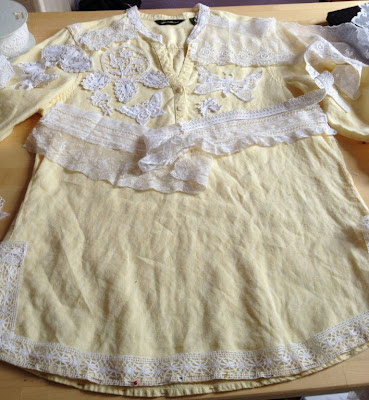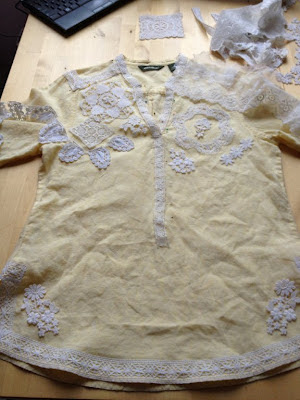One of the women in my French quilting guild (called Patchwork here) handed me a wadded up mass of lace yesterday. She (over 60 years old) found it in the attic, it was most likely leftover from something her mother made.
Notice, they are black.
Old black lace in good condition is so hard to find.
Why, you ask?
Well black was
worn when your loved ones died, they were called widow's weeds. For 2 years after your loved one's death you were in
mourning. Most ladies did not invest a lot of money into making or buying many
different outfits during this time period. This means the outfits they did have were worn
constantly. After 2 years of near constant use, well, the black lace did not
hold up well.
I have looked for
and collected black old laces, but they are few and far between. When I do find
them, they are in tatters. Use? yes. Maybe the dying techniques used to get the color black.
My two new additions are cotton, machine made and in wonderful
shape. I was given 1 1/2 yds of the narrower lace and 2 1/2 yards of the wider lace.
Since I have been collecting, I now have a small box
of black laces, come take a tour. It won't take long, I promise.
The first is vintage. I have about 1 yard. It has a couple of small holes in the netting
toward the top, but it appears to never have been used. It is 6 inches wide.
I have 2 of these,
they were head scarves attached to hats in some way. I pulled out the gathering
to wash them when I first got them. One had a hat pin attached still (dead give-away) One is damaged the other is in very nice
shape.
They are a machine
made cotton lace of a very high quality. The netting between the designs is a fine cotton netting.
This is a head scarf. Just beautiful and in very nice condition.
I am keeping it in
mind for my next (not too soon ,I hope) solemn event.
Lastly, I have a
collar. At first I thought it was a type of Battenburg lace (Luxeuil), since it
appears from a distance that way. On
closer inspection it is a form of Alençon lace (point d'Alençon) The workwomanship
is fantastic and if you notice in the picture there are silk backed embroidered
medallions sewn into some of the open spots. Silk does not have a good life
span. One of the 3 medallions on this piece, the one that goes to the back is
in very bad shape. This collar came from lace bits I bought in Beaune France at
a flea market several years ago. I am thinking of framing it someday, or maybe not.
If I find the perfect fabric for it, it would become something fun to wear. I
would have to remove the silk bits. For now, since I have had no real yardage
of usable black lace it has remained in its box.
This ends my tour of my black
collection of lace bits. Like I said, it did not take long.































